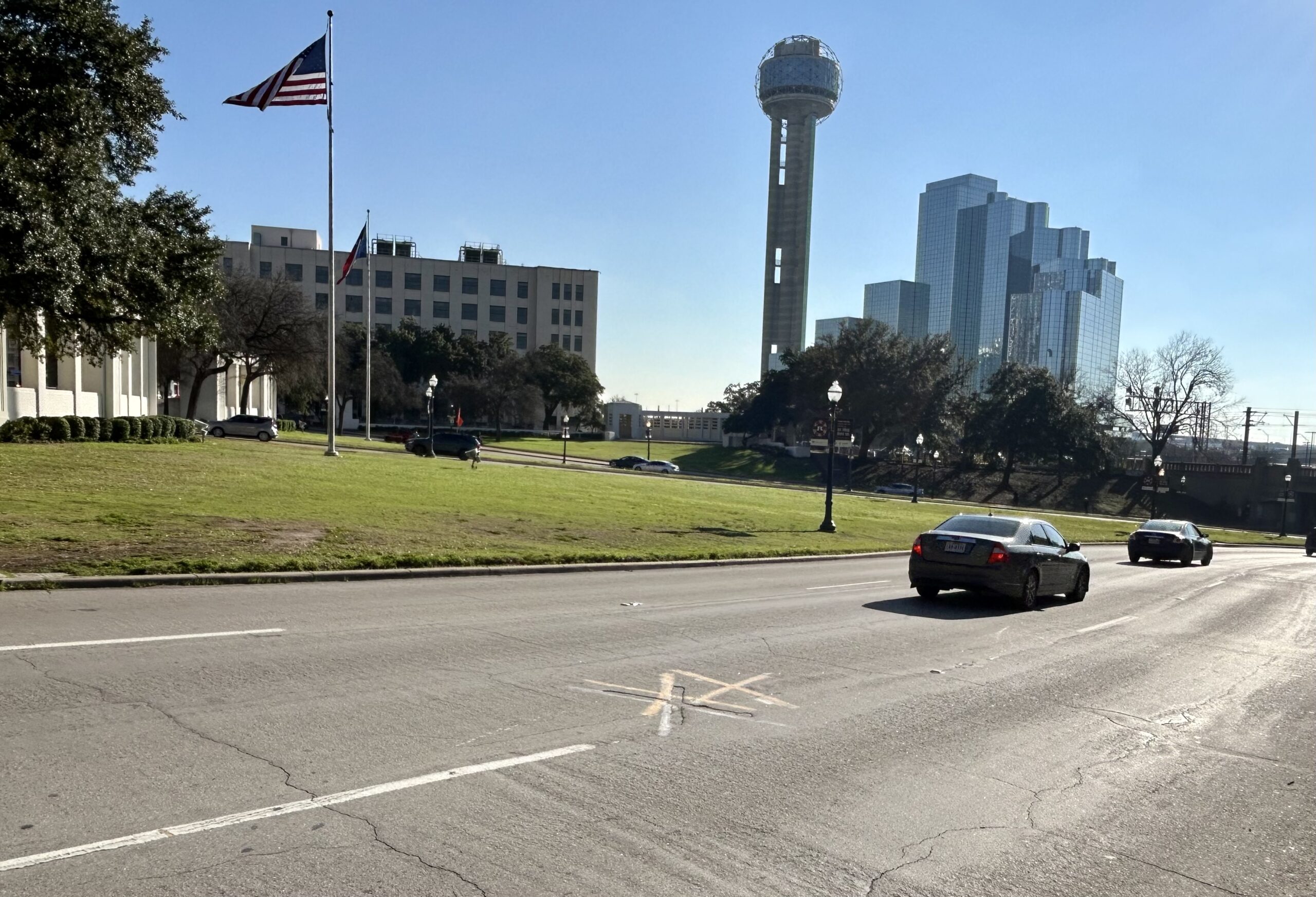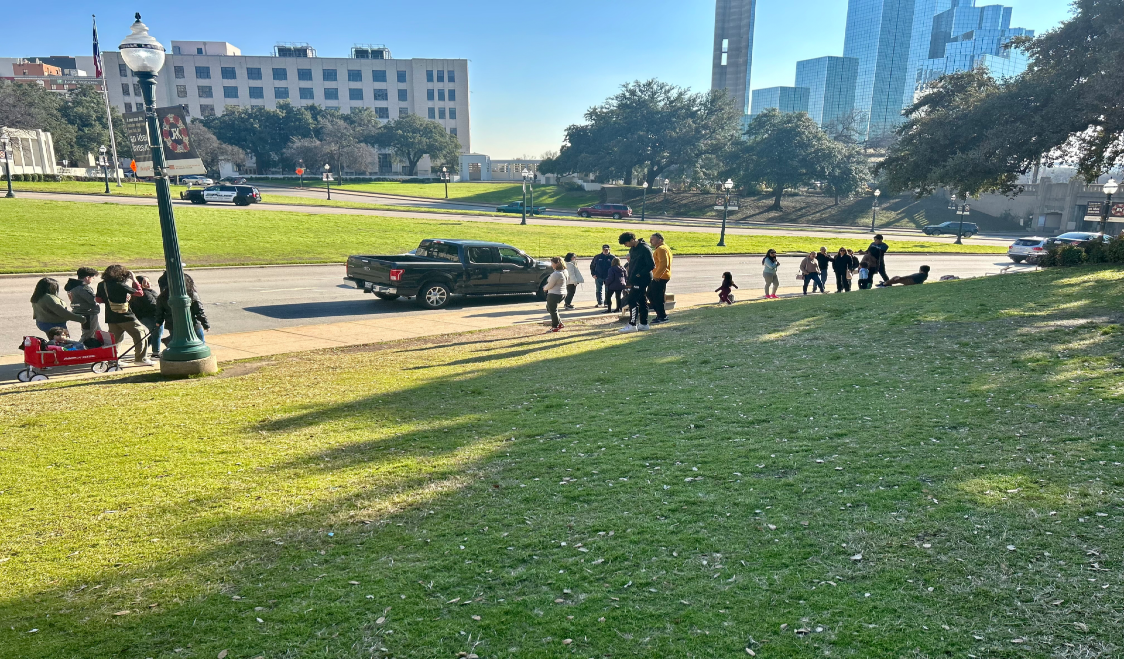A few days ago, I was standing on the “grassy knoll” on Elm Street in Dallas, just a few feet away from where white painted X’s on the street marked the exact spot where President Kennedy was shot. I cornily confess: I felt chills running down my neck.

A friend and I had just toured The Sixth Floor Museum At Dealey Plaza, a riveting experience where you actually walk the floor inside the Texas School Book Depository — and pass through the southeast corner where Lee Harvey Oswald pulled the trigger. Looking down through that same window, you can see the X’s on the street.
The museum installation includes all kinds of tangible artifacts, videos and photos from the JFK assassination and its decades of political and investigative aftermath. But the item that stood out to me most was a simple text box, where the museum’s historians described the lead-up to the murder. The first four sentences spoke volumes:
“Dallas was the most conservative city on the President’s Texas itinerary. Kennedy’s sweeping civil rights bill, introduced in June 1963, would doubtless have cost him millions of votes, particularly in the south. National polls taken in November 1963 showed that the President’s popularity had fallen to a 59% rating. In the nine months prior to the Texas trip, John F. Kennedy received over 400 death threats nationwide.”
The summary also reported that “small extremist groups were vocal in the community,” and that a month earlier, U.N. Ambassador Adlai Stevenson had been spat on and smacked on the head with a poster at a public event. Several of JFK’s advisors expressed “serious concerns about (his) visit to Dallas.”

As I read the text, I reflected on the fact that the spirit of this acrimony and political anxiety from 60 years ago doesn’t deviate all that much from today’s. Surely this is no revelation, as the history of the United States is rife with points of friction that split the country, or worse, resulted in political violence. Eight of our presidents have suffered serious assassination attempts, dating all the way back to 1835. Half of them survived.
Many folks believe that the political division in America today is “worse than ever.” I admit that there are days when I feel that way. Then I remember that I’ve only been around for 56 years.
Is the vitriol we’ve been going through over the last decade more dire than when we fought against our fellow countrymen in the Civil War? Is it worse than the widespread race riots and right-wing vigilantes that suffused America between 1917-1922? Scarier than the Red Scare? Uglier than Vietnam, racial violence in the South and the murders of Kennedy, RFK and MLK in the 1960s?

To be sure, the afternoon of January 6 was sickening beyond description. And it was without question the result of a months-long, intentional effort led by one person. Any sane person, whether officeholder or civilian, would fail a lie-detector test miserably if they claimed otherwise.
Determining when America was at its most troubled point is not really the most productive or even timely question. A more relevant debate going on today centers on whether our democratic form of government would survive another four years if Donald Trump got elected to a second term.
Many talking heads passionately make the case that we would not recover. That Trump would make the kind of undemocratic changes — some of which he’s described — that would permanently damage American government.
I would say they’re wrong.
Americans are known for puffing out our chests and touting our constitutional democracy to the rest of world as a landmark achievement in human self-governance. Which it was.
But some of those same people are the ones asserting that one lame-duck presidency would destroy it all in four years; that this “Great American Experiment” is actually totally vulnerable to a single chief executive.
Reminder: This is how it works! Three branches of government. Three pillars that are constantly bouncing up against each other: A balance of power that has worked for 234 years and counting.
In the weeks after the 2020 Election, when Trump and his team were working to overturn it, I wrote that I hoped they would keep on trying. Take it as far as they can go. And they did — to a length that many of us could not have fully imagined.
But the system held. As it always has. As displeased as we are with our institutions, they were the reasons our government emerged from Jan. 6 intact: law enforcement agencies, the judiciary, Congress, and the Fourth Estate.
Our system has survived many rogue individuals, from Andrew Jackson to J. Edgar Hoover to Joe McCarthy to Richard Nixon — even early-forming disasters like George Santos. They come and they go.
Will Trump be on the Colorado ballot? The Maine ballot? Our system will decide.
Will Trump and his alleged co-conspirators be found guilty of the crimes they must stand trial for? Our system will decide — that’s how they were indicted in the first place.
If returned to office, will Trump do things that half the country abhors? Of course he will. It is his raison d’être.
But disgusting personal behavior and controversial political decisions — coming from one person in one branch of the federal government — are quite unlikely to crash our entire system.
Americans can be cocky, often to the point of being obnoxious. We’re proud that we’ve been able to operate the world’s oldest living representative democracy for over two centuries — because it’s a system that makes for a rocky ride. Hard to steer. As Michael Douglas said in his speech at the end of The American President:
“America isn’t easy. America is advanced citizenship. You’ve gotta want it bad, ’cause it’s gonna put up a fight.”
So true. Nonstop debate. All the way back to our original national argument over Federalism versus Anti-Federalism. The Federalist Papers were published for this very reason. And then the Constitution was ratified. Still around.
So forget all the doomsday bluster about what might happen starting next year. The system will hold.
In the meantime, the most effective way to fight for this “advanced citizenship” we enjoy is to think for yourself; volunteer for a campaign; donate to a candidate…vote. Whatever potential crisis comes next, it’s the Americans we elect whose fidelity to the Constitution will be tested.
At the end of the day, it is our collective decisions that comprise our system. Nothing more and nothing less. It has ever been thus.
May we choose wisely.
**The Golden Mean has moved to Substack, where all current subscribers will continue to receive free content through the end of 2024. Sign-up here!


